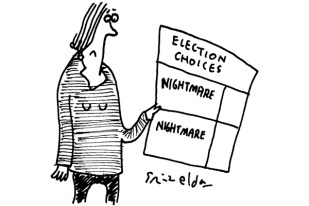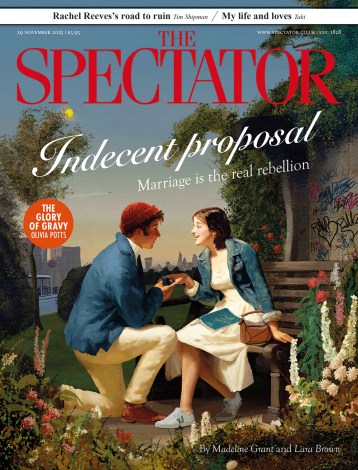New York

A biography of Freud to my left, a black leather lounger to my right. We were 30 minutes in. ‘Well,’ said the psychiatrist, sitting up in his chair, ‘what you’re describing sounds like ADHD.’ Oh? ‘And what we normally prescribe for that is Adderall.’ There they were. Ten blue, oblong capsules, in an orange cylinder with a white top. 20mg, extended release. To be taken once a day. They’d help me focus, sit still and finish my work. It’s odd that I didn’t come across them last year, while a student at New York University. They say Adderall, the brand name for a mix of amphetamine salts, is the most popular among the ‘study drugs’ now ubiquitous on American campuses. Around 30 per cent of American students have taken stimulants at least once, and the higher-ranking the university, the more common it is. Undergraduates find multiple uses for ‘Addy’ — hunkering down with it, cramming with it, crushing it into powder then snorting it at parties. Done thus, I’m told it’s much like cocaine, though apparently ‘tastes worse’ and ‘turns phlegm bright blue’. But the overdiagnosis and overmedication of ADHD — attention deficit hyperactivity disorder — is no joke. Rather, it is a ‘national disaster of dangerous proportions’. Those are the words of eminent American psychologist Dr Keith Conners, who speaks to us from the grave (no, really: prior to his death in 2017, in order to ‘provide one last word of warning’, he co-wrote his own obituary in the BMJ). Fifty years ago, Dr Conners practically invented ADHD, when he noted impulsivity and hyperactivity in small children as being worthy of clinical attention. From his own work, and from serious review of the literature, he established that the population of affected children is 2 to 3 per cent. But in the 1990s, the combined effect of loosening the diagnostic criteria (so that exuberance, eccentricity and the ordinary struggles of day-to-day life were all potentially pathological) and allowing American drug companies to have another go at marketing amphetamines (which had been curtailed by regulation in the 1970s) created a perfect storm of supply and demand. At the last count, there were approximately six million under-18s diagnosed with ADHD and 16 million ADHD prescriptions for adults under 40 in the US. And the student population has become a full-blown (albeit secondary) market for these drugs. Relatively speaking, campus healthcare is both comprehensive and value for money — and prescriptions come cheap. This doesn’t last for ever, of course. No longer a student, I called Columbia University Medical Center to book a psychiatry appointment as part of my research for this piece — only to be told that since they don’t take my insurance, a consultation would cost $1,000. Eventually, I found a psychiatrist online who agreed to see me for $350. The prescription would have been an additional $100, but the pharmacist, feeling sorry for me, gave me a coupon. What are all these student junkies going to do after they graduate? One Harvard undergraduate told me that he had initially turned up to the campus health centre with depression, whereupon the psychiatrist gave him a quick questionnaire, decided he had ADHD and asked: ‘Are you interested in pursuing medication?’ Having tried Concerta and Ritalin (from his friend’s and his sister’s supplies) he requested (and got) the superior Adderall, which he now uses almost daily. Another student at a liberal arts school was prescribed 30mg of Adderall at 18, after his therapist’s recommendation was rubber-stamped by a psychiatrist. He soon developed the ‘self-reinforcing idea that I could succeed only with Adderall’. This idea of ‘success’ involved staying up all night watching porn, unable to maintain an erection, and chain-smoking cigarettes, packs at a time. Another Harvard student, having suffered a sports-related head injury, tried his friend’s prescription then immediately approached an off-campus neuropsychologist ‘with the express purpose of getting Adderall, because I thought it was the closest thing to fixing me around’. Within weeks, he was taking as much as 200mg a day (ten times the standard dose). Sometimes, in a dark library corner, he would snort Addy off his iPad. He soon dropped out of school. After that, it was drink, hard drugs and yet more Adderall. Having gone through rehab, he’s now back at Harvard — five years older than his peers — and determined to get his degree. One thing you can do after getting a prescription is ‘sell it to your friends who haven’t been so industrious or so well trained in the theatre to get themselves a diagnosis’, an Ivy League undergraduate explains. ‘You make some money and have more fun and everyone benefits.’ Student market prices typically range from $3 to $25 per pill, depending on the dosage, as well as the time of year. Demand is always highest around finals. Which is why it’s prudent to get orders in early. Great care must be taken not to seem too ‘greedy’, however, especially when dealing with students who prefer to ‘gift’ prescriptions. ‘If you’re not already a drug dealer it does feel weird to sell your Adderall,’ a student user at a small liberal arts university tells me. An ADHD sufferer who recently graduated from a midwestern public university (who exhibited symptoms from a young age, went through a rigorous evaluation, began by flushing his pills down the toilet in protest, and now takes them responsibly) recalls being perturbed when he arrived on campus and immediately found himself to be a flame among moths. During his senior year, he was assigned a new roommate who wouldn’t take no for an answer. He’d gone out for a walk when the roommate rummaged through his belongings and stole his Adderall. ‘Just shows you how desperate people are to get their hands on these drugs,’ he says, dolefully. Psychiatrist Dr Allen Frances, who helped shape the American Psychiatric Association’s definition of ADHD in the 1990s, and wrote a book on the ‘medicalisation of ordinary life’ called Saving Normal, told me ‘the only defence against excessive ADHD diagnosis is the one that’s being used in England — having guidelines that are restrictive’. Still, he warns: ‘The more drug companies and privatisations invade the territory of the NHS, the more you will have the horrible overdiagnosis and treatment [like in the US].’ With Brexit looming, he is not the only one concerned about the Americanisation of British medicine. I spoke to a British psychiatrist who has worked in the NHS for nearly 30 years. He said that while there will always be people willing to ‘buy a diagnosis’, a system based on such an incentive is a perverse one. There’s really no upper limit, either. The total revenue for pharmaceutical companies in 2019 for ADHD drugs is $13 billion, a figure that has been steadily climbing for the past five years, and has increased fifty-fold in the past two decades. The psychiatrist also said that while an ADHD diagnosis can be helpful in certain circumstances, with many patients, the clinically appropriate thing to tell them is ‘there’s not a lot wrong with you, just get on with your life’. It is telling that, despite my best efforts, I was able to find only one undergraduate at a British university (Oxford) who had any experience with ‘study drugs’. In this case, it was Modafinil: in verb form, ‘moding’. The extent of this student’s experience had been to swallow a single pill, gifted by a friend, who had ‘got it quite easily online’. He had felt so energised that, having whistled through his work, he forgot to eat, went for a midnight run, stayed up until 4 a.m. and felt ‘as sick as a dog’ the next day. He had no desire to do it again. I asked whether he’d ever seen anyone snort it at parties. Laughing, he said he had not. But no one laughs like this in America. One student told me that ‘it feels unfair if you’re not using it. Almost like you’re playing baseball and one person’s taking steroids and you’re not’. As relatable as this sentiment may be, there’s next to no empirical evidence to support it. In fact, of the research that is out there, it would seem that, even among those with ADHD diagnoses, those not on prescription drugs tend to have marginally better grades than those on them. Unlike sport-enhancing drugs, which improve the quality of one’s performance, ‘study drugs’ enhance quantity and frequency. So, while they cannot transform a bumbling dum dum into T. S. Eliot, they can turn T. S. Eliot into T. S. Eliot on speed. Because that’s effectively what Adderall is — speed. Brain-fuel, making gravity seem weaker and the back of your cereal box the most interesting thing you’ve ever read. As for why these drugs are so popular, I had wondered that myself. During the first 20 days of August, I, a blushing Adderall virgin, published 7,781 words. During the next ten days, I, M(+)addy, published 9,780 words. I also published 100 per cent more articles and 150 per cent more blog posts, though the drug-assisted ones were noticeably shorter, and the number of long-form pieces remained the same. The most robust conclusion I can draw from this wee experiment, then, is that — all other things being equal — on Adderall, I wrote 25 per cent more words in half the amount of time. Which doesn’t include this article, of course — written on (as well as about) Adderall. Though I intend this to be the last piece I write under the influence of it, I do shudder to recall, as the ink on my cheque dried, the psychiatrist’s parting words: ‘Come to think of it, no. I’ve never had a patient, once prescribed, go off them.’





Comments